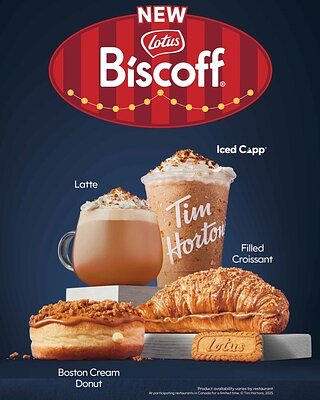
Tim Hortons' Holiday Menu: A Strategic Blend of Flavor and Function
Tim Hortons' new holiday menu, featuring Biscoff and protein-rich drinks, reveals a strategic play for market share and evolving consumer tastes.
Tim Hortons Unwraps Strategic Holiday Menu with Biscoff Collaboration and Wellness Focus
TORONTO, ON – November 12, 2025 – Tim Hortons, Canada's ubiquitous coffee and bake shop, has unveiled its annual holiday menu, showcasing a notable collaboration with Biscoff alongside an array of new and returning festive delights. This year’s seasonal offerings extend beyond mere indulgence, reflecting a calculated strategy to capture evolving consumer preferences and intensify competition in the quick-service restaurant (QSR) sector during the critical holiday season.
At the heart of the new menu is a partnership with the globally recognized Biscoff brand, bringing its distinctive caramelized flavor to Tim Hortons' iconic products. The lineup includes a Biscoff Boston Cream Donut, a Biscoff Filled Croissant, a Biscoff Latte, and a Biscoff Iced Capp. These limited-time items are designed to generate buzz and drive customer traffic, a critical component of QSR performance during seasonal peaks.
The Strategic Sweet Spot: Brand Collaborations in QSR
The Biscoff collaboration is a prime example of a growing trend in the QSR industry: strategic brand partnerships. For Tim Hortons, this move is more than just adding a new flavor; it's about leveraging the established appeal of another popular brand to refresh its offerings and attract new demographics. Hope Bagozzi, Chief Marketing Officer for Tim Hortons, emphasized this synergy, stating, "Combining the delicious crunch of Biscoff cookies with Tims favourites, like our Iced Capp and Boston Cream, makes for a collaboration that's as special and festive as the season itself."
Such collaborations are not new territory for either brand. Tim Hortons India has seen success with recurring Biscoff partnerships, and Lotus Bakeries, the maker of Biscoff, frequently engages in similar ventures to amplify its reach. These alliances offer mutual benefits: increased brand visibility, shared marketing efforts, and the creation of novel, limited-time offerings that drive consumer excitement and urgency. In a market saturated with choices, a unique flavor profile from a beloved partner can be a powerful differentiator, converting fleeting interest into tangible sales.
Parent company Restaurant Brands International (RBI) has consistently highlighted the importance of limited-time offers (LTOs) in driving comparable sales growth. With Tim Hortons and RBI's International business collectively contributing approximately 70% of RBI's earnings, the strategic deployment of a high-profile holiday menu is paramount. The success of these seasonal campaigns directly impacts overall financial performance, as evidenced by Tim Hortons Canada's 4.2% comparable sales growth in Q3 2025.
Navigating Consumer Wellness: The Rise of Functional Beverages
Beyond the festive indulgence, Tim Hortons' new menu also signals an adaptation to broader consumer trends, particularly the increasing demand for healthier and more functional food and beverage options. The introduction of the Brown Sugar Protein Iced Latte, boasting 17 grams of protein per medium serving, stands out as a direct response to this shift.
This move aligns with a growing consumer focus on wellness, where ingredients like protein are sought after for their perceived benefits in satiety, muscle recovery, and overall health. The protein content in this new latte is notably higher than traditional Tim Hortons lattes, which typically offer around 6 grams of protein in a small serving. The use of a specialized "lactose-free protein milk 'beverage'" underscores the deliberate effort to cater to health-conscious individuals without compromising on taste.
The QSR landscape is witnessing a broader embrace of functional beverages. Competitors like Starbucks have also introduced protein-enhanced options, such as protein-boosted cold foams, allowing customers to customize their drinks with additional nutritional value. This trend reflects an industry-wide recognition that today's consumers expect more from their quick-service meals than just convenience; they seek options that align with their lifestyle and dietary goals. By integrating such items, Tim Hortons aims to broaden its appeal beyond its traditional coffee and donut base, tapping into the lucrative and expanding wellness market.
The Festive Market Battleground: Competing for Seasonal Spend
The launch of Tim Hortons' holiday menu is set against the backdrop of an intensely competitive QSR market, where every major player vies for a share of seasonal consumer spending. The holiday period is a critical time for revenue generation, and each chain strategically crafts its festive offerings to attract customers and differentiate itself.
Starbucks Canada, for instance, launched its holiday menu earlier in November, bringing back beloved beverages like the Peppermint Mocha and Caramel Brulée Latte, alongside new innovations such as the Iced Sugar Cookie Cream Matcha Latte. Their food offerings also include a mix of returning favorites and new items like the Polar Bear Cake Pop, signaling a comprehensive approach to capturing holiday cheer.
McDonald's Canada, while sometimes offering more localized or unique items like a "Triple Pickle McCrispy Sandwich," typically focuses its festive McCafé lineup on traditional seasonal flavors such as Peppermint Mocha. Dunkin', primarily in the US market, also joins the fray with new items like the Cookie Butter Cloud Latte and festive packaging, demonstrating a concerted effort across the industry to create a compelling seasonal experience.
Tim Hortons' Biscoff collaboration and its protein-enhanced beverage are thus not just isolated product launches but strategic maneuvers within this larger battle for market share. By offering a blend of nostalgic comfort through classic holiday flavors and innovative appeal through brand partnerships and wellness-oriented options, Tim Hortons positions itself to remain a formidable contender in the evolving QSR landscape, aiming to deepen customer engagement and drive robust seasonal sales. The fight for the consumer's holiday dollar is fierce, and innovation remains the key to standing out.
📝 This article is still being updated
Are you a relevant expert who could contribute your opinion or insights to this article? We'd love to hear from you. We will give you full credit for your contribution.
Contribute Your Expertise →